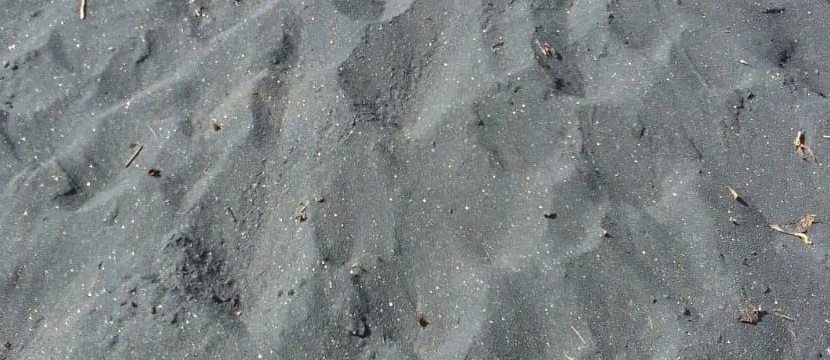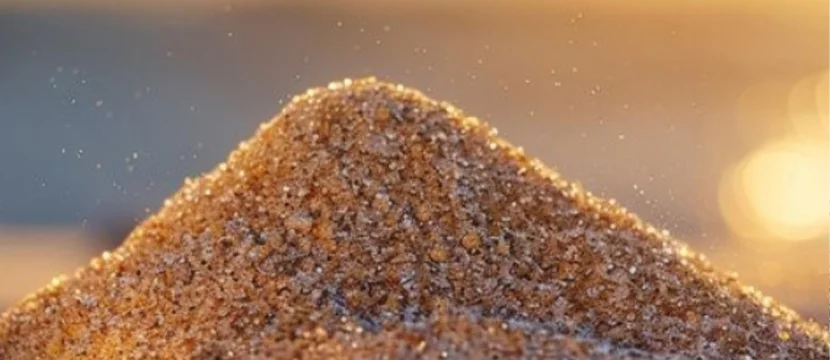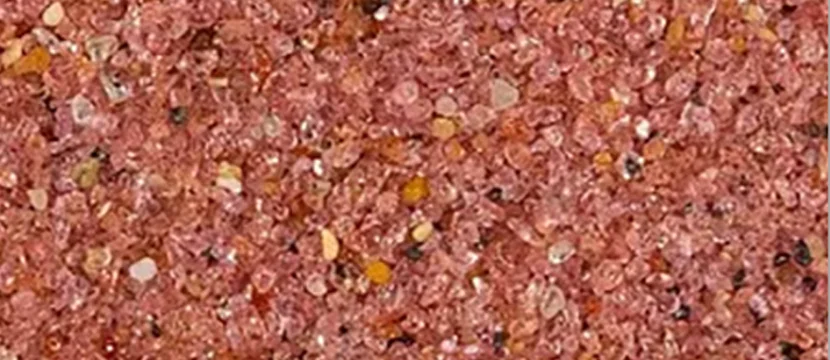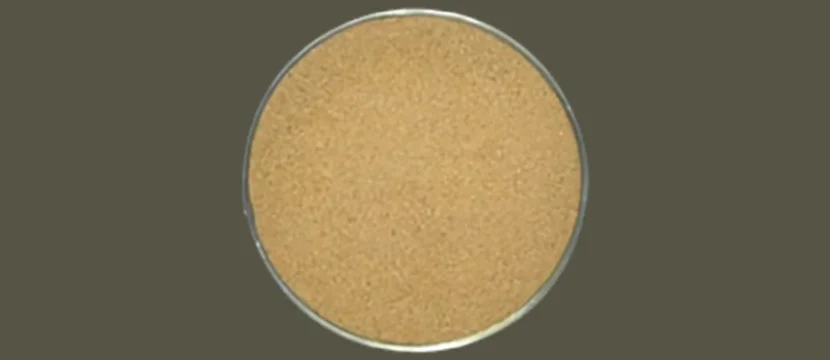Beach Sand Minerals
- Ilmenite
- Rutile
- Zircon
- Garnet
- Sillimanite
Ilmenite

Ilmenite sand is a naturally occurring, weakly magnetic mineral composed primarily of iron titanium oxide (FeTiO3). It’s a key source of titanium dioxide (TiO2), a valuable compound used in various applications like pigments, welding, and even some metal components. The sand is typically heavy and appears as dark grains with high specific gravity and magnetic properties.
Here’s a more detailed look at ilmenite sand:
Composition and Properties:
- Chemical Formula: FeTiO3
- Color: Iron-black or steel-gray
- Appearance: Heavy, dark grains with high specific gravity
- Magnetic Properties: Weakly magnetic
- Crystal Structure: Similar to corundum and hematite
Uses:
Titanium Dioxide Production:
Ilmenite sand is the main source of titanium dioxide (TiO2), which is widely used as a pigment in paints, plastics, and other materials.
Welding Industry:
It’s used in welding rods and fluxes.
Metal Manufacturing:
Ilmenite sand is used to produce durable, lightweight metal components for applications like aircraft engine parts and sporting equipment.
Other Applications:
It can be used as a fluxing agent in blast furnaces and as a sand-blasting abrasive.
Sources:
- Found along shorelines, often in beach sands.
Rutile

Rutile sand is a naturally occurring sand primarily composed of titanium dioxide (TiO2) (typically over 90%). It’s a valuable mineral found in heavy mineral sands, along with other minerals like ilmenite, zircon, and monazite. Rutile sand is a key source of titanium and is widely used in various industries.
Key Properties and Uses:
High Titanium Dioxide Content:
Rutile sand’s primary component is titanium dioxide (TiO2), making it a valuable feedstock for producing titanium dioxide pigment, which is widely used in paints, paper, plastics, and textiles.
Titanium Metal Production:
It’s also a crucial raw material for producing titanium metal, a strong, lightweight, and corrosion-resistant metal used in aerospace, medical implants, and sporting goods.
Welding Fluxes:
Rutile sand is used as a coating on welding electrodes, improving the welding process.
Other Applications:
Rutile sand finds uses in various other applications, including the production of synthetic rutile and as a component in some ceramics.
Mining and Processing:
Rutile sand deposits are often found in beach and river sands, requiring specialized mining and processing techniques to extract and purify the mineral.
Indian Market:
India is a significant producer of rutile sand, and it is widely used in the Indian welding electrode industry.
Zircon

Zircon sand, also known as zirconium silicate (ZrSiO₄), is a naturally occurring mineral found in ancient heavy mineral sand deposits. It is primarily used as a raw material for various industrial applications due to its unique physical and chemical properties.
Properties of zircon sand
- Chemical Composition: Zirconium silicate (ZrSiO₄), with a theoretical content of 67% zirconia (ZrO₂) and 32% silica (SiO₂). It may also contain small amounts of hafnium, aluminum, iron, and titanium oxides, as well as traces of uranium and thorium.
- Physical Properties:
- High Melting Point: Approximately 2200°C to 2550°C, according to LKAB Minerals.
- High Hardness: 7.5 on the Mohs scale.
- High Density: Specific gravity ranging from 4.6 to 4.7 g/cm³.
- Low Thermal Expansion: Good resistance to thermal shock.
- High Thermal Conductivity.
- Chemical Inertness: Resistant to most acids and alkalis.
- Low Wettability by Molten Metals.
- Color: Typically ranges from colorless to pale yellow or brownish, but can also be red, green, or blue depending on impurities and heat treatment.
Applications of zircon sand
Zircon sand and its derivatives find extensive use across various industries:
Ceramics:
- As an opacifier in ceramic glazes to enhance whiteness and brightness.
- Used in the production of ceramic tiles, sanitaryware, and other ceramic products.
- Adds resistance to scratching and mechanical damage to ceramic products.
Refractories:
- Used in the manufacture of high-temperature refractories such as furnace linings and kilns due to its high melting point and thermal stability.
Foundries and Castings:
- As a molding material in sand casting, investment casting, and as a mold coating in die casting processes.
- Improves dimensional accuracy and surface finish of castings.
- Reduces the need for post-casting machining and cleaning operations.
Zirconia and Zirconium Chemicals:
- Raw material for the production of zirconium oxide (ZrO₂), a highly durable ceramic material used in various applications, including medical prostheses and advanced technical ceramics.
- Used in the production of zirconium chemicals for applications in the nuclear industry, pigments, coatings, and catalysts.
Glass:
- Can absorb X-rays and increase the refractive index and toughness of glass, particularly in older cathode ray tubes (CRT) applications. While demand for this use has diminished with newer display technologies like LCD and plasma, zircon is still used in their faceplate glass production.
Garnet

Garnet sand is a naturally occurring mineral abrasive known for its hardness, durability, and versatility. It’s a group of silicate minerals with a similar crystal structure, with almandine garnet being the most common type used in industrial applications.
Key properties of garnet sand
- Hardness: 7.5 – 8.0 on the Mohs scale, making it a highly effective abrasive.
- Durability: Resists fracturing and breakdown during abrasive applications, allowing for multiple reuse cycles.
- Grain Shape: Angular, sharp particles provide effective cutting action in applications like blasting and cutting.
- Low Dust Emission: Produces significantly less dust compared to other abrasives like silica sand, leading to improved operator visibility and safer working conditions.
- Environmental Friendliness: Naturally occurring, inert, and non-toxic, making it an eco-friendly option. It also contains virtually no free silica, minimizing the risk of silicosis.
- High Specific Gravity: Allows for higher flow rates, higher loading, and better filtration in water treatment applications.
Applications of garnet sand
- Garnet sand finds extensive use in various industries due to its unique characteristics:
- Sandblasting: Effective for surface preparation, cleaning, and removing rust, paint, and coatings from various materials like steel, aluminum, fiberglass, and wood.
- Waterjet Cutting: Micro grains of garnet sand, particularly #80 and #120 mesh sizes, are mixed with high-pressure water to cut materials like metal, stone, and ceramics.
- Water Filtration: Coarser grains (like 12/40 mesh) are used in multimedia filtration systems to remove suspended particles and heavy minerals from industrial wastewater and commercial water filtration.
- Abrasive Papers: Widely used in the manufacturing of abrasive papers for finishing and surface preparation applications.
- Other Applications: Glass etching, metalworking (including deburring and edge reduction), shipbuilding, automotive industry, aerospace industry, construction (shaping and smoothing stone), and woodworking.
Sillimanite sand

Sillimanite sand is a high-alumina (aluminum silicate mineral (Al2SiO5) , high-melting point material derived from the mineral sillimanite, known for its low thermal expansion and resistance to high temperatures. It’s primarily used in the production of refractories, which are essential in industries like metal and alloy making, ceramics, and foundries.
Key Properties:
- High Alumina Content: Makes it suitable for high-temperature applications.
- Low Thermal Expansion: Resists cracking and deformation under temperature fluctuations.
- High Melting Point: Can withstand extreme heat environments.
- High Specific Gravity: Around 3.2.
- Fine Particle Size: Typically smaller than 600 µm.
- High Density: Between 3.23 and 3.27 g/cm³.
- High Corrosion Resistance:
- Hardness: 6.5-7.5 on the Mohs scale.
Applications:
- Refractories: Used in linings for furnaces and kilns in various industries.
- Ceramics: As a component in ceramic bodies.
- Foundries: Employed in making molds and cores.
- Paint Industry: Some suppliers on IndiaMART list white sillimanite sand for paint applications.
Copyright 2025 Jaipuri Minerals. All Rights Reserved.


